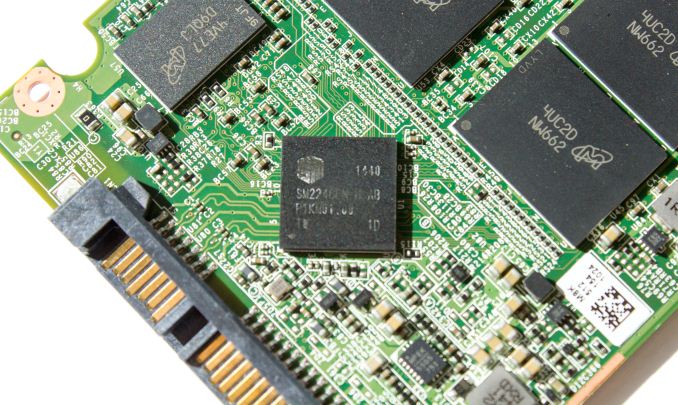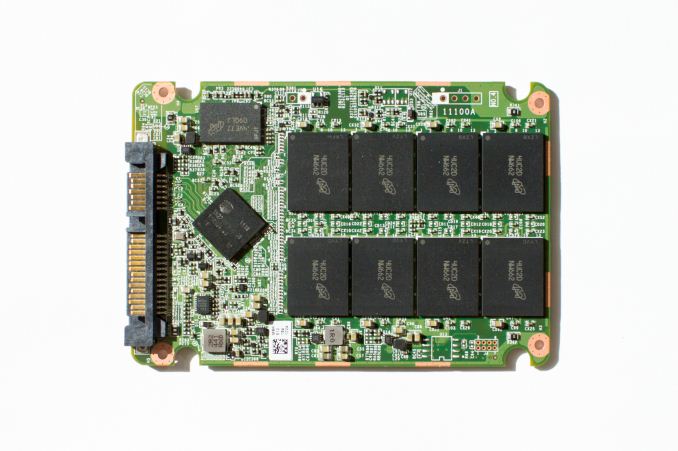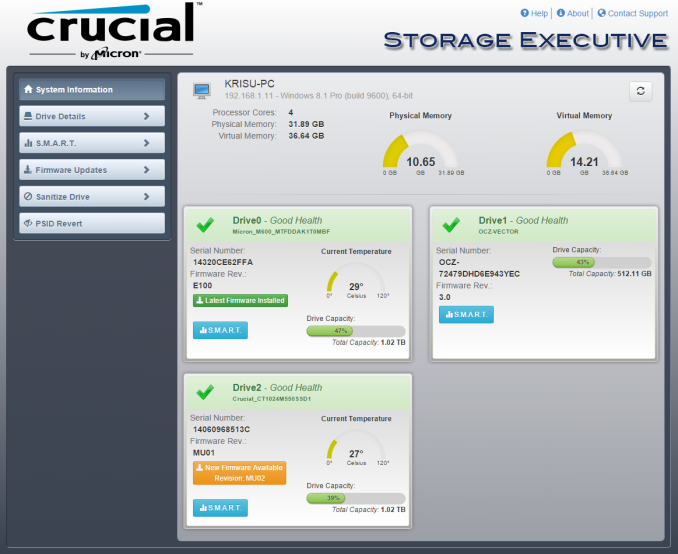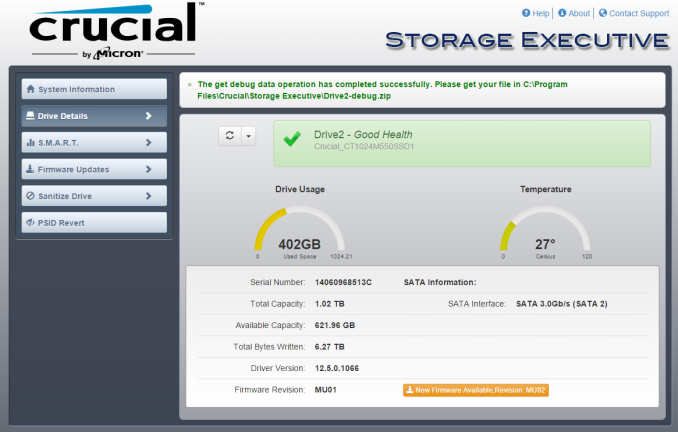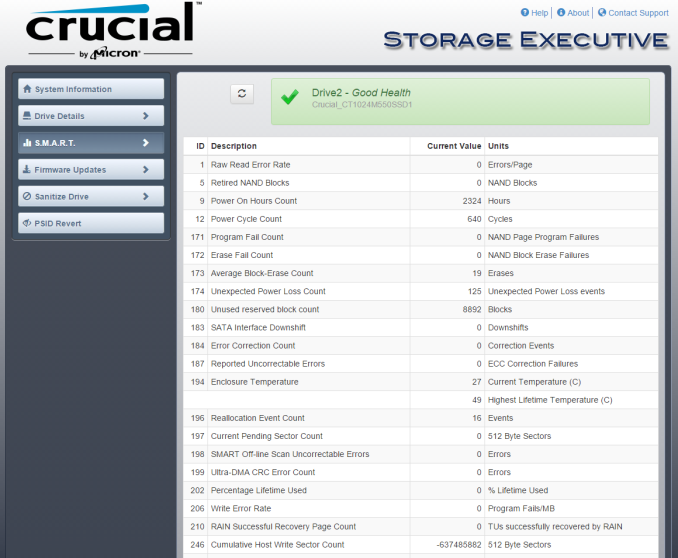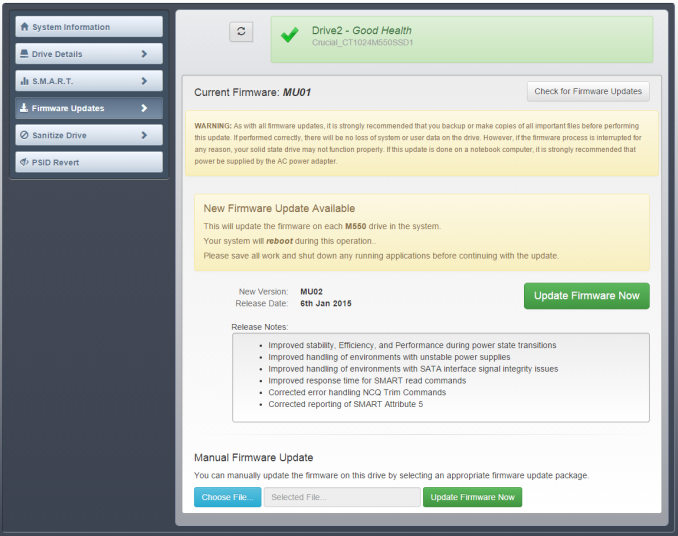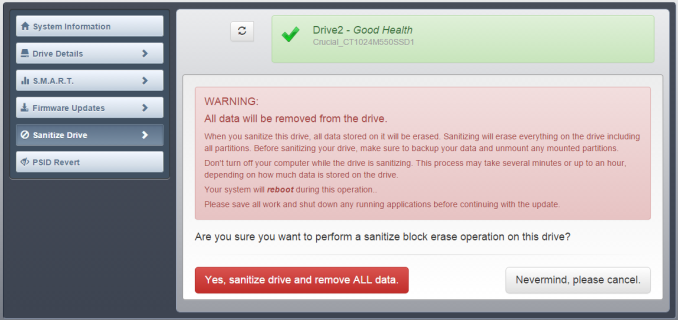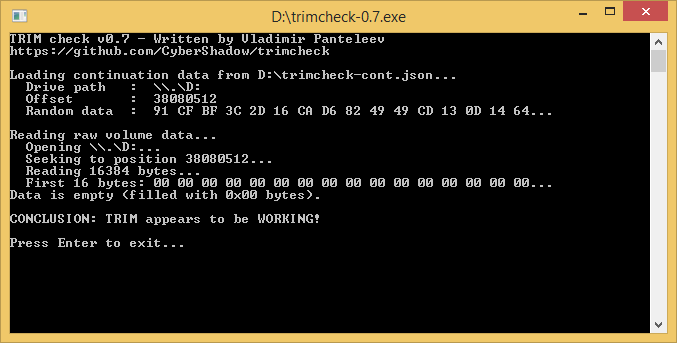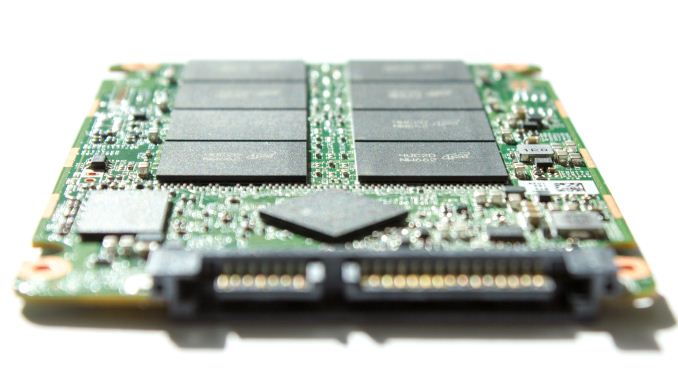
Original Link: https://www.anandtech.com/show/9144/crucial-bx100-120gb-250gb-500gb-1tb-ssd-review
Crucial BX100 (120GB, 250GB, 500GB & 1TB) SSD Review
by Kristian Vättö on April 10, 2015 1:20 PM EST- Posted in
- Storage
- SSDs
- Crucial
- Micron
- Silicon Motion
- BX100
- SM2246EN
- Micron 16nm
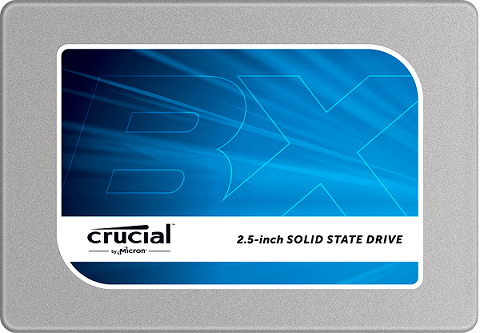
Crucial has been doing very well in the client SSD market during the past year. Crucial's/Micron's ability to quickly roll out the 16nm NAND node definitely paid off because the MX100 really nailed it when it came to cost and overall value. The MX100 set a new bar for mainstream SSD prices while still providing solid performance in typical client-level workloads. It gained a strong recommendation from us and has remained at the top of my "what to buy list" for nearly a year now, and honestly it has been one of the most popular mainstream SSD during its lifespan.
Back at CES Crucial introduced some fresh faces to its client SSD lineup by announcing the MX200 and BX100, which are replacing the MX100 and the aging M550. The MX200 is essentially a retail version of Micron's M600 that was launched last year and which we already reviewed, but the BX100 is a totally new product from several angles. First off, the 'BX' series is new to Crucial's lineup and denotes a budget-oriented drive, whereas the 'MX' brand is kept for higher performance drives. It has become a common strategy in the SSD industry to offer a mainstream drive that focuses solely on cost along with a higher performance model with better feature set for the enthusiasts and professionals. Crucial already kind of had that strategy with the M500 (later MX100) and M550, but the two lacked any real differentiation in both performance and feature set, so the BX100 and MX200 are here to fix that.
The BX100 isn't Crucial's first try with a low-cost drive as some of you may recall the infamous Crucial v4, which was frankly one of the worst SSDs I've ever reviewed. It looks like Crucial learned its lesson because we never saw a successor to the v4. Fortunately the BX100 has a lot more potential as is powered by Silicon Motion's SM2246EN controller. Crucial/Micron worked closely with Silicon Motion to develop the firmware for the BX100, so the firmware is unique to Crucial and we won't be seeing it in any other SM2246EN based drive. I've covered the technical details of the SM2246EN controller in our ADATA Premier SP610 review and our tests have shown that it's an excellent controller for mainstream client SSDs, so on paper at least the BX100 shouldn't end up the same way as the v4 did. Generally speaking Silicon Motion has been gaining a lot of market share lately and the new partnerships with Crucial/Micron and SanDisk has made the company become a tier-one controller manufacturer.
| Crucial BX100 Specifications | |||||
| Capacity | 120GB | 250GB | 500GB | 1TB | |
| Controller | Silicon Motion SM2246EN | ||||
| NAND | Micron 16nm 128Gbit MLC | ||||
| DRAM (DDR3-1600) | 256MB | 512MB | 1GB | ||
| Sequential Read | 535MB/s | 535MB/s | 535MB/s | 535MB/s | |
| Sequential Write | 185MB/s | 370MB/s | 450MB/s | 450MB/s | |
| 4KB Random Read | 87K IOPS | 87K IOPS | 90K IOPS | 90K IOPS | |
| 4KB Random Write | 43K IOPS | 70K IOPS | 70K IOPS | 70K IOPS | |
| DevSleep Power Consumption | 15mW | ||||
| Slumber Power Consumption | 115mW | ||||
| Max Power Consumption | 4W | ||||
| Encryption | N/A | ||||
| Endurance | 72TB | ||||
| Warranty | Three years | ||||
Since Crucial's motivation behind the BX100 is to differentiate the product lineup, the BX100 doesn't have the hardware encryption support that we got used to with the previous drives. While the SM2246EN is capable of supporting Opal encryption, it makes sense for Crucial not to include it in the BX100 because there's always additional validation costs that go along a feature. Besides, the MX200 has full encryption support and obviously Crucial wants to guide the buyers who need the feature towards the more expensive (and likely higher profit) MX200.
The BX100 does however have the same partial power loss protection that protects against lower page corruption during sudden power losses (I suggest you read the M600 review for the full details of Crucial's power loss implementation). The implementation itself is a bit different from the Marvell based drives (I don't have the details, but I suspect it has to do with the SM2246EN controller), but the design provides the same >200µs of holdup to ensure that ongoing upper page programs won't corrupt the data in the lower page.
The BX100 is using the same Micron 16nm 128Gbit MLC NAND as the MX100 and MX200. I covered Micron's 16nm NAND in more detail in the MX100 review, but in short it is a die shrink of the 20nm node and utilizes the same high-K dielectric cell structure which is likely the reason why Micron was able to roll out the 16nm so quickly with good yields (whereas Toshiba/SanDisk seem to be having issues with their 15nm node since it has yet to find its way into a shipping product).
| 120GB | 250GB | 500GB | 1TB | |
| Raw NAND Capacity | 128GiB | 256GiB | 512GiB | 1024GiB |
| # of NAND Packages | 4 | 4 | 8 | 16 |
| # of Die per Package | 2 | 4 | 4 | 4 |
| Over-Provisioning | 12.7% | 9.1% | 9.1% | 9.1% |
With the BX100, Crucial is moving to user capacities that are similar to Samsung's EVO SSD series. That gives the BX100 a little more over-provisioning over the traditional 2^n capacities and I also suspect that even hundreds like 500GB are easier to market than 480GB or 512GB given that consumers are accustomed to hard drive capacities.
| AnandTech 2015 SSD Test System | |
| CPU | Intel Core i7-4770K running at 3.5GHz (Turbo & EIST enabled, C-states disabled) |
| Motherboard | ASUS Z97 Deluxe (BIOS 2205) |
| Chipset | Intel Z97 |
| Chipset Drivers | Intel 10.0.24+ Intel RST 13.2.4.1000 |
| Memory | Corsair Vengeance DDR3-1866 2x8GB (9-10-9-27 2T) |
| Graphics | Intel HD Graphics 4600 |
| Graphics Drivers | 15.33.8.64.3345 |
| Desktop Resolution | 1920 x 1080 |
| OS | Windows 8.1 x64 |
- Thanks to Intel for the Core i7-4770K CPU
- Thanks to ASUS for the Z97 Deluxe motherboard
- Thanks to Corsair for the Vengeance 16GB DDR3-1866 DRAM kit, RM750 power supply, Hydro H60 CPU cooler and Carbide 330R case
A Look at Storage Executive - Crucial's SSD Toolbox
One of the areas where Crucial has been lacking is the software. Nearly every SSD vendor provides some sort of software/toolbox for its SSDs nowadays, but until January Crucial had been the exception to the rule. I discussed this with Crucial/Micron last year and they understood their weakness on the software front, and also disclosed that there's a toolbox in the works. At CES the curtain was finally lifted when Crucial released its own toolbox called the Storage Executive.
Unlike the other toolboxes we've seen, the Storage Executive runs in the default browser. However, it still comes as an installer (which is quite large at 147MB for the 64-bit version) and has to be installed, but instead of running as its own window the Storage Executive utilizes the default browser for the interface. Since I'm not a software developer, I'm not sure if this is easier to implement versus a separate window, but honestly it doesn't really matter because a toolbox isn't something you need to keep open at all times, so Crucial's implementation works just fine for when it's needed.
The welcoming screen that's shown above shows the common tidbits of data that nearly all toolboxes show. This includes general information about the system such as the operating system and the amount of memory, along with slightly more detailed information about the installed drives (serial number, firmware version, temperature and used capacity).
The 'Drive Details' section shows more details about the drives, including the interface and driver version, but honestly it could use some additional details (e.g. life remaining). The drop-down button next to the refresh icon includes a 'Get Debug Data' feature that saves the drive's and system's data to a ZIP file that can then be sent to Crucial's support team for remote analysis of the drive and its potential issues.
The SMART tab includes the usual SMART data that can be read by numerous utilities.
The ability to easily upgrade the firmware is probably the most important feature in a toolbox and the Storage Executive is pretty straightforward with that. It automatically checks for updates and also features the release notes, so the end-user will know what has been changed in the newer firmware.
Drive sanitation is Crucial's code name for secure erase command, which will return the drive back to its factory state (i.e. all blocks are erased). There's also a PSID revert function that can be used to revert a TCG Opal encrypted drive back to unencrypted state using the physical security ID (i.e. PSID) that's printed on the SSD's label, which is very handy if you're dealing with encrypted drives because in case you lose the encryption key the drive will essentially become a brick as there's no way to access it. Obviously, PSID revert will erase all data in the drive, but the drive can then be repurposed. I did confirm that the PSID revert works and it doesn't require anything else but the PSID on the label.
All in all, from a functionality perspective, the Storage Executive is Crucial's first attempt at a software package, and it shows. It lacks features compared to what Samsung and Intel have at the moment, but it does offer the necessary features that one needs for troubleshooting and maintenance. That said, since this is the 1.0 version, there will be more features added in the future that should bring the Storage Executive closer to what the competitors are offering today.
Performance Consistency
We've been looking at performance consistency since the Intel SSD DC S3700 review in late 2012 and it has become one of the cornerstones of our SSD reviews. Back in the days many SSD vendors were only focusing on high peak performance, which unfortunately came at the cost of sustained performance. In other words, the drives would push high IOPS in certain synthetic scenarios to provide nice marketing numbers, but as soon as you pushed the drive for more than a few minutes you could easily run into hiccups caused by poor performance consistency.
Once we started exploring IO consistency, nearly all SSD manufacturers made a move to improve consistency and for the 2015 suite, I haven't made any significant changes to the methodology we use to test IO consistency. The biggest change is the move from VDBench to Iometer 1.1.0 as the benchmarking software and I've also extended the test from 2000 seconds to a full hour to ensure that all drives hit steady-state during the test.
For better readability, I now provide bar graphs with the first one being an average IOPS of the last 400 seconds and the second graph displaying the IOPS divided by standard deviation during the same period. Average IOPS provides a quick look into overall performance, but it can easily hide bad consistency, so looking at standard deviation is necessary for a complete look into consistency.
I'm still providing the same scatter graphs too, of course. However, I decided to dump the logarithmic graphs and go linear-only since logarithmic graphs aren't as accurate and can be hard to interpret for those who aren't familiar with them. I provide two graphs: one that includes the whole duration of the test and another that focuses on the last 400 seconds of the test to get a better scope into steady-state performance.
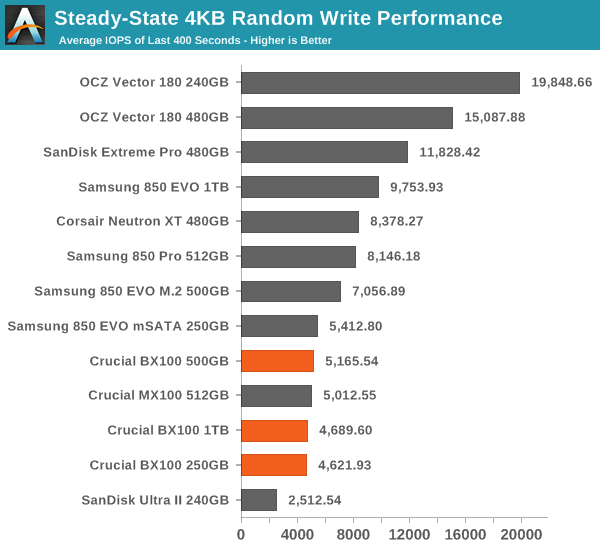
Steady-state performance has never been Crucial's nor Silicon Motion's biggest strength, but 5K IOPS is fairly average for a value-oriented SSD and for the target group the performance is just fine.
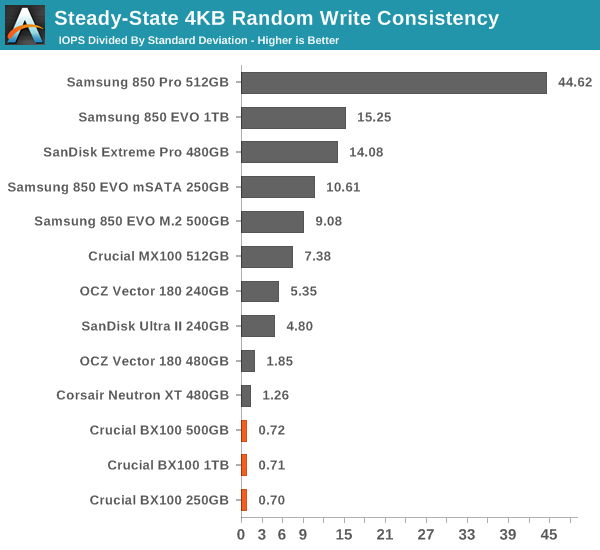
As some of you have mentioned in the comments, displaying standard deviation alone isn't very useful because it totally ignores the IOPS, so I've changed the graph to IOPS divided by standard deviation during the last 400 seconds of the run. The SM2246EN has always been very inconsistent and it appears that the BX100 is no exception since it has the worst consistency we've tested so far.
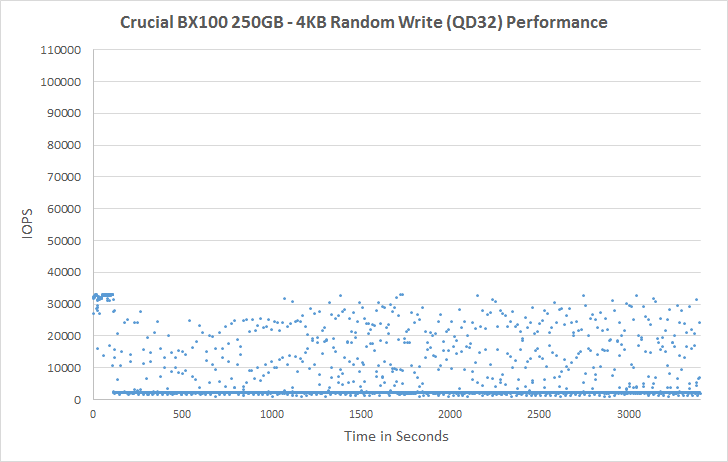 |
|||||||||
| Default | |||||||||
| 25% Over-Provisioning | |||||||||
Putting the IOPS under a microscope shows that the consistency really is poor. That's nothing new to the SM2246EN and the graph is very similar to the other SM2246EN drives we have tested, although I was hoping that Crucial would have tuned the firmware for better consistency. On the other hand, the users buying the BX100 are unlikely to put the drive under harsh 4KB random write workloads, so all in all the consistency isn't much of an issue.
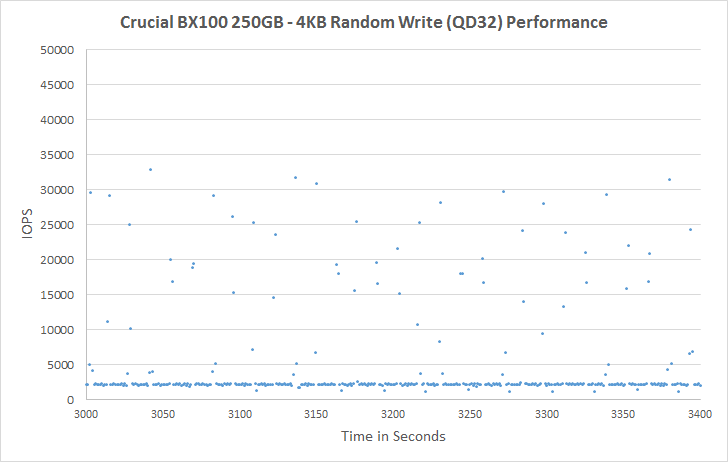 |
|||||||||
| Default | |||||||||
| 25% Over-Provisioning | |||||||||
AnandTech Storage Bench - The Destroyer
The Destroyer has been an essential part of our SSD test suite for nearly two years now. It was crafted to provide a benchmark for very IO intensive workloads, which is where you most often notice the difference between drives. It's not necessarily the most relevant test to an average user, but for anyone with a heavier IO workload The Destroyer should do a good job at characterizing performance. For full details of this test, please refer to this article.
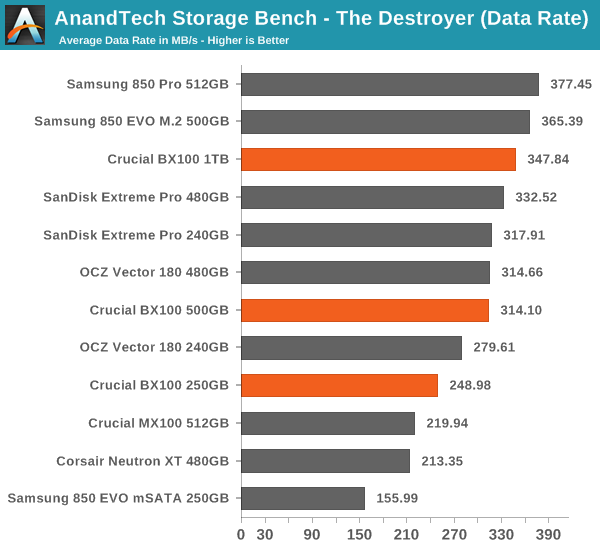
Despite the lack of IO consistency, the BX100 does very well in our heaviest The Destroyer trace. It's easily faster than the MX100 and quite close to the higher-end SSDs as well in both data rate and latency.
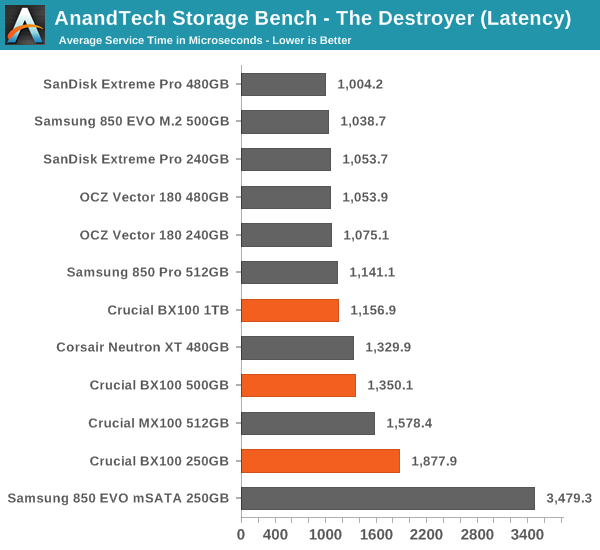
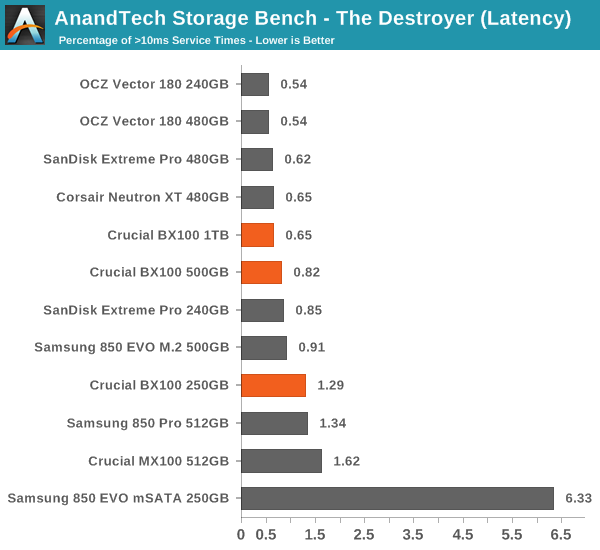
The share of high latency IOs is very reasonable too, suggesting that the consistency is fine under real-world workloads.
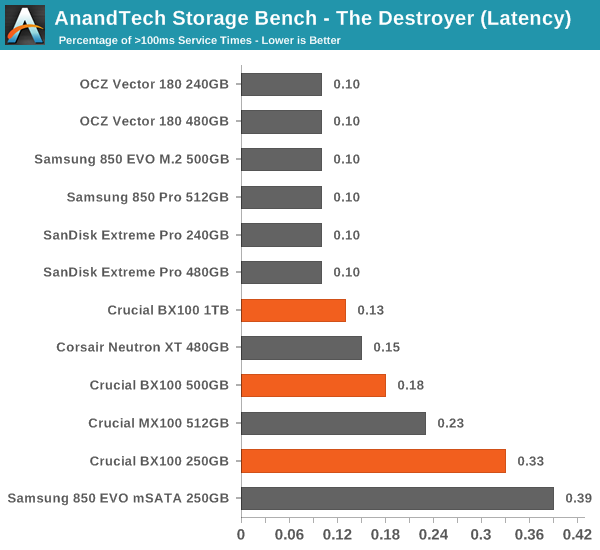
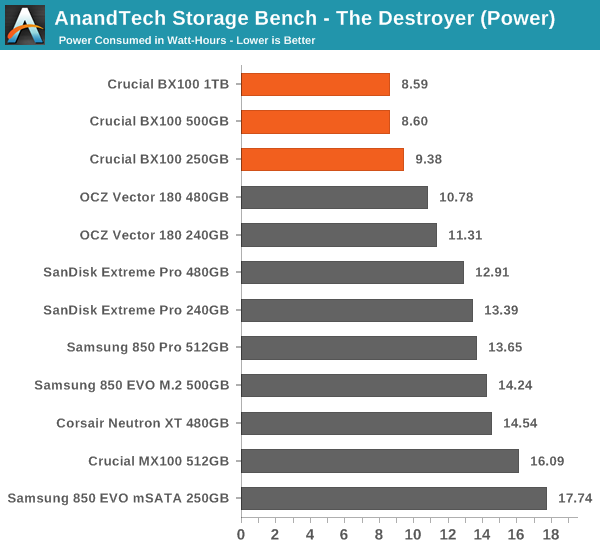
And finally the power consumption where the BX100 shines in. Even though it's not the fastest drive on the market, it's by far the most power efficient and the difference to the MX100 is nearly twofold.
AnandTech Storage Bench - Heavy
While The Destroyer focuses on sustained and worst-case performance by hammering the drive with nearly 1TB worth of writes, the Heavy trace provides a more typical enthusiast and power user workload. By writing less to the drive, the Heavy trace doesn't drive the SSD into steady-state and thus the trace gives us a good idea of peak performance combined with some basic garbage collection routines. For full details of the test, please refer to the this article.
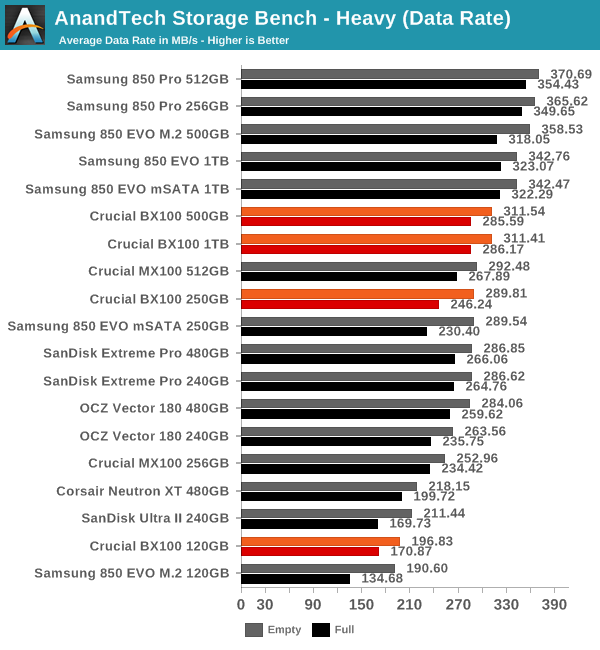
The BX100 continues to be a strong performer in our Heavy trace. It's not able to match the Samsung drives, but overall it provides very good performance for a value drive.
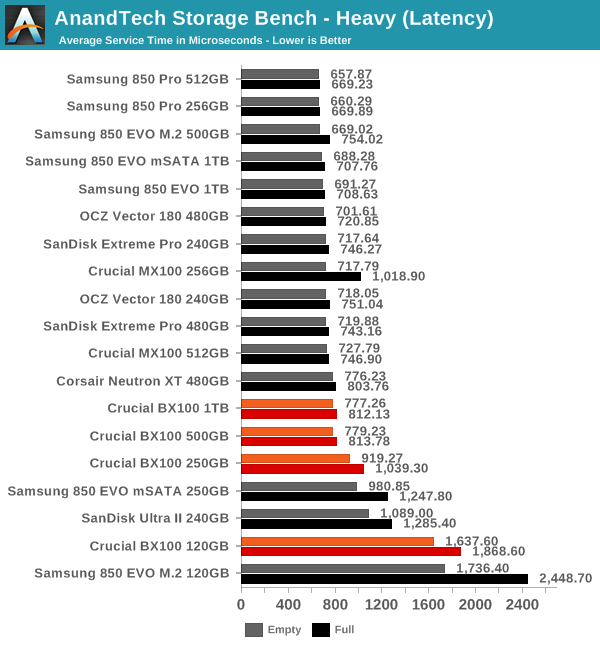
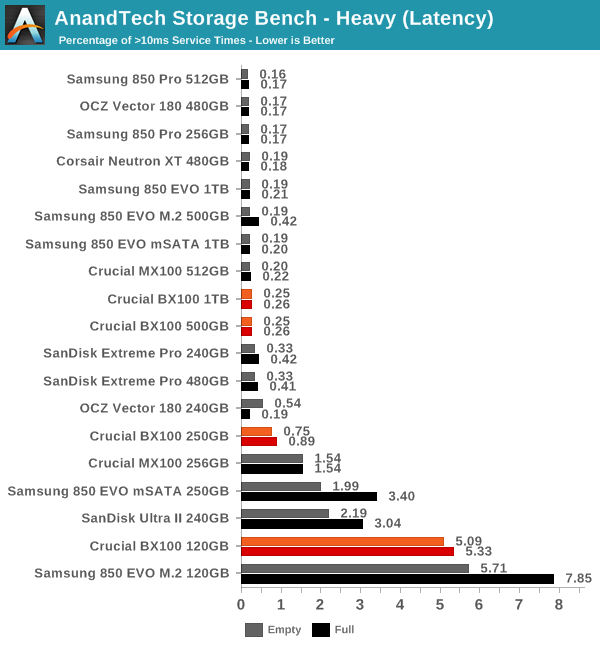
The number of high latency IOs isn't alarming either and the 120GB BX100 actually performs better than the 120GB 850 EVO, especially when the drive is full.
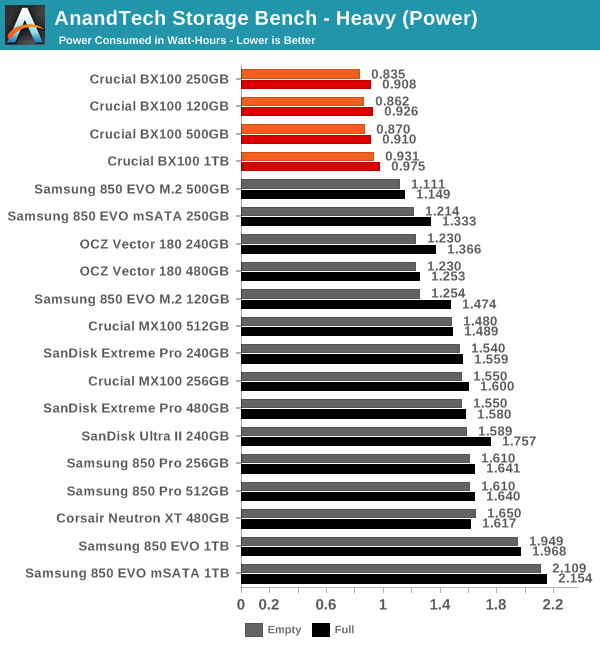
The power consumption is again excellent. While we have known that the SM2246EN is very power efficient, these tests further assure its efficiency and advantage over competing solutions.
AnandTech Storage Bench - Light
The Light trace is designed to be an accurate illustration of basic usage. It's basically a subset of the Heavy trace, but we've left out some workloads to reduce the writes and make it more read intensive in general. Please refer to this article for full details of the test.
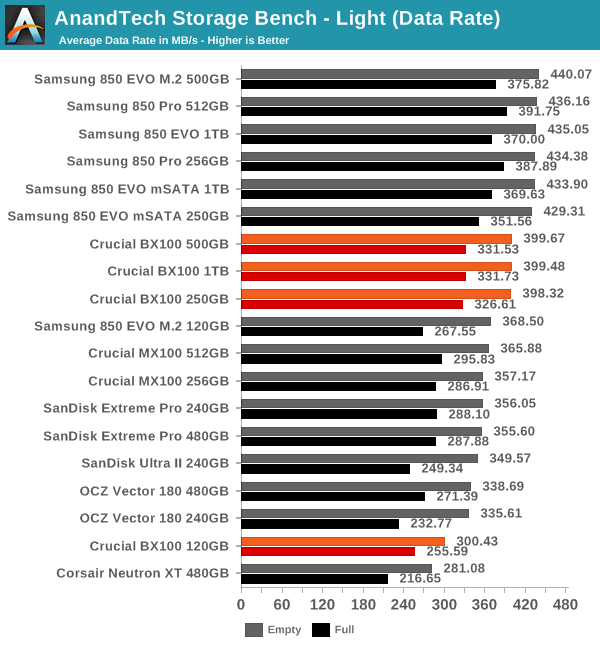
While the differences in our Light trace are typically marginal, the BX100 manages to have a slight advantage over the MX100 and several competing drives, although Samsung still maintains its crown.
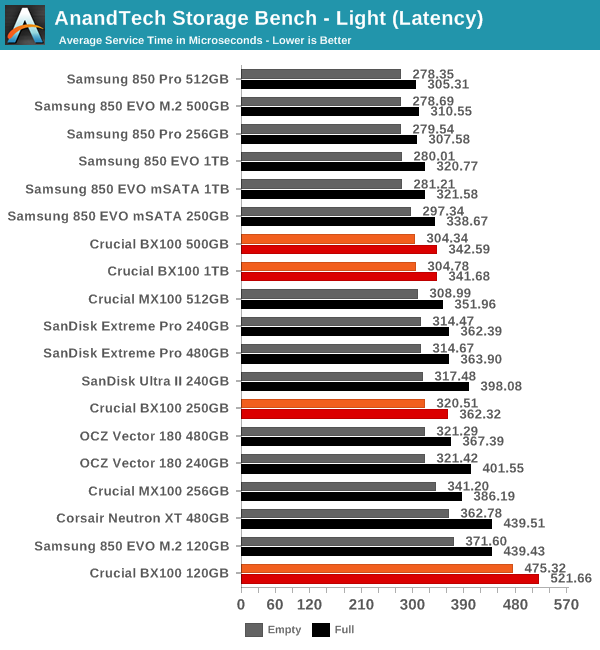
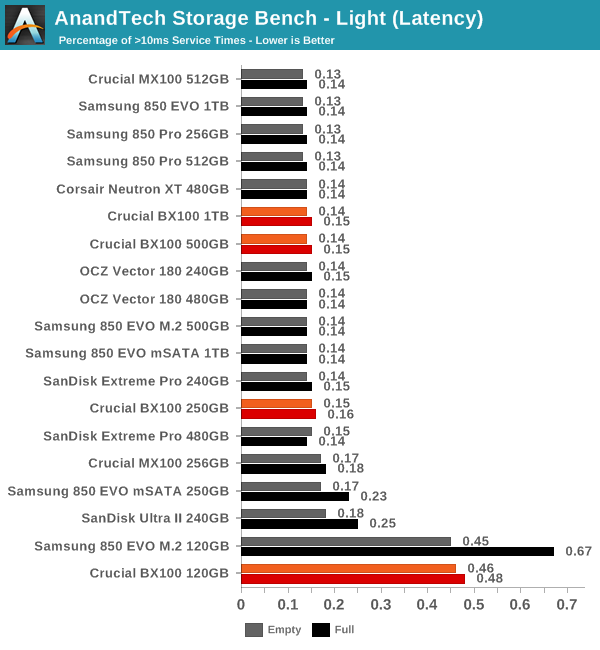
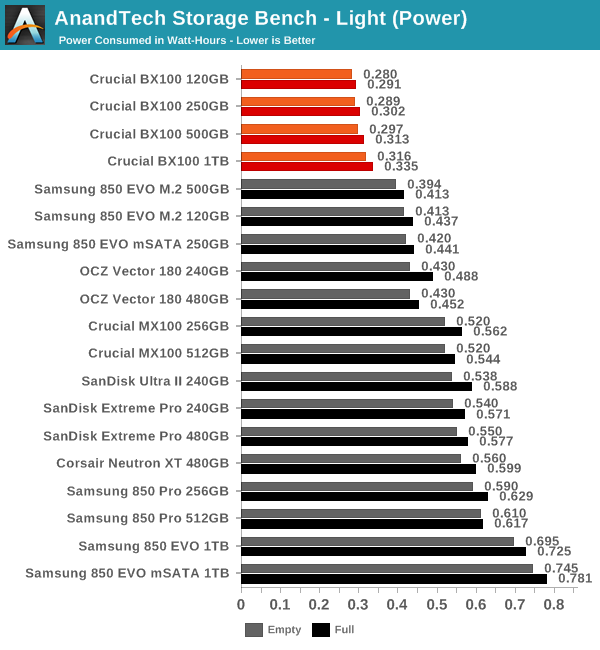
Power consumption remains brilliant and I'm honestly surrpised by how big the difference actually is.
Random Read Performance
For full details of how we conduct our Iometer tests, please refer to this article.
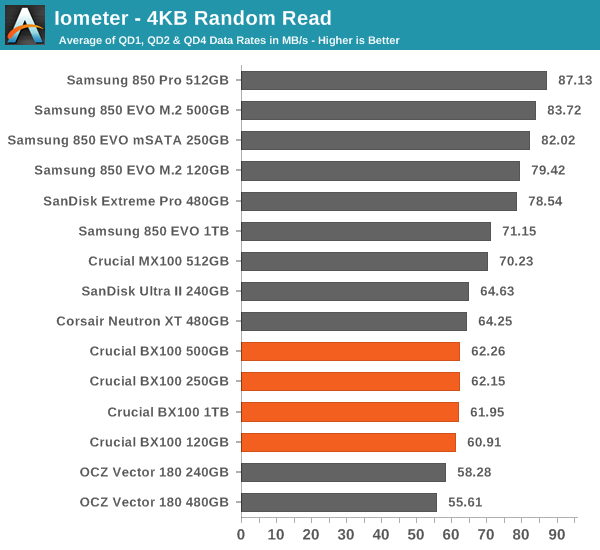
Random read performance at low queue depths is decent, but not class-leading. Similar to what we saw in the Storage Bench tests, only Samsung has a notable advantage over other manufacturers.
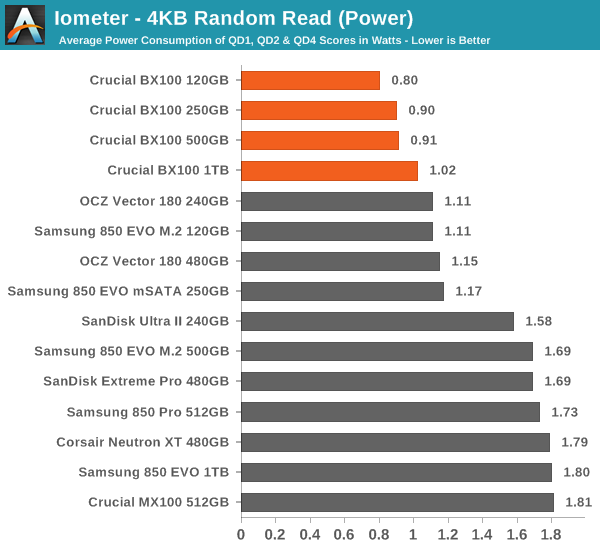
Power consumption, on the other hand, is outstanding as the BX100 is the most efficient drive we have tested.
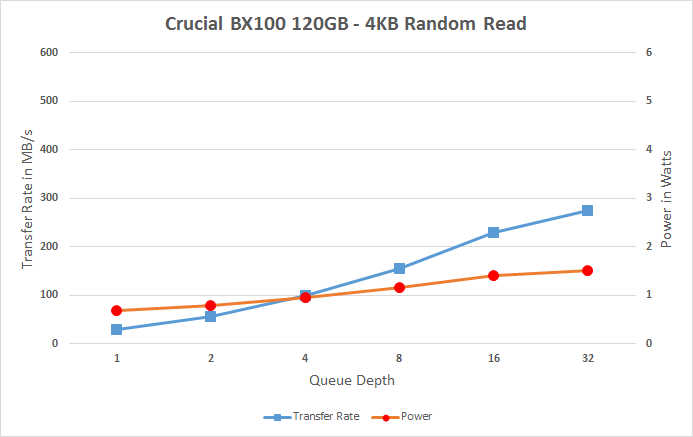 |
|||||||||
Since the SM2246EN is purely a client controller and fairly lightweight in general, it doesn't offer very aggressive scaling and tops out at 300MB/s, whereas many competing drives are able to achieve up to 400MB/s at the highest queue depths. Fortunately that's not relevant to client workloads, so the lack of high QD performance isn't that much of an issue.
Random Write Performance
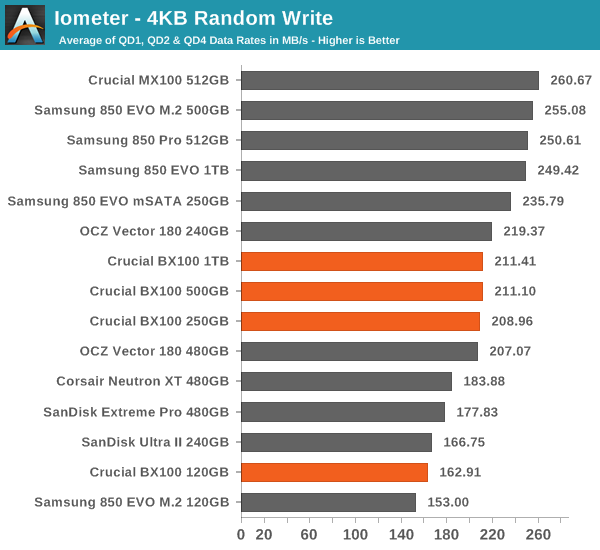
Random write performance is also average, but the power consumption is again excellent and it should be noted that the power draw doesn't increase substantially with higher capacities (but neither does performance).
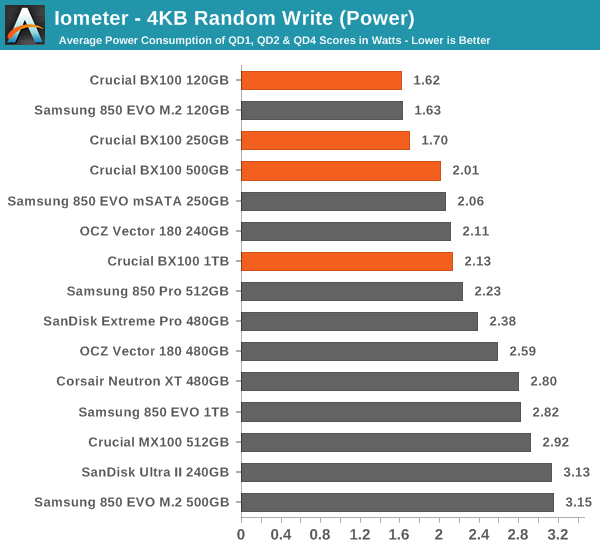
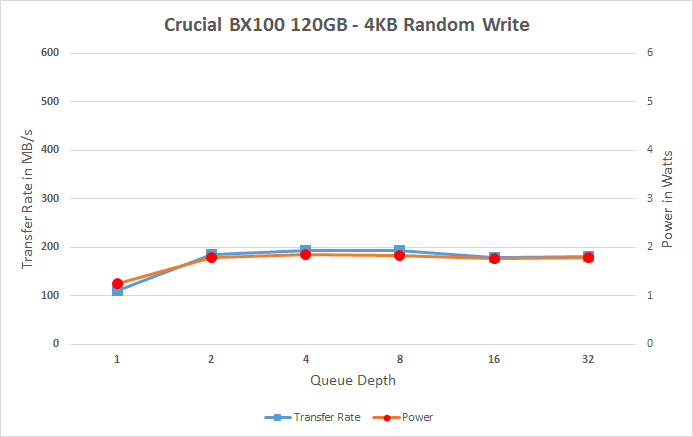 |
|||||||||
Performance scaling at higher queue depths isn't that impressive, but the BX100 does scale very well at low queue depths and the performance at QD1 is very good, which is ultimately the most important queue depth for client workloads.
Sequential Read Performance
For full details of how we conduct our Iometer tests, please refer to this article.
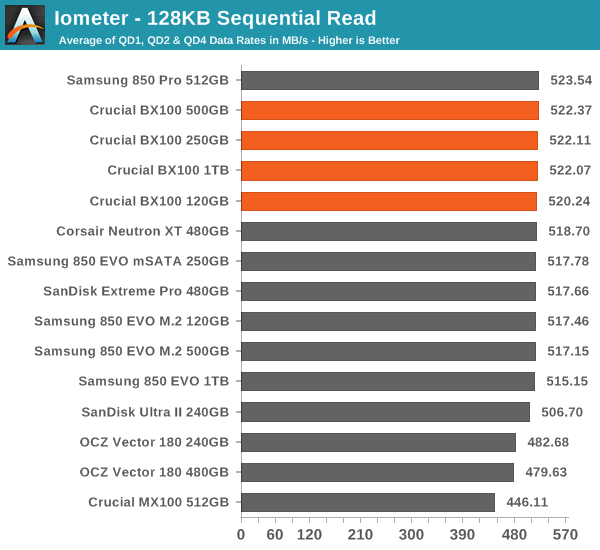
Sequential read performance for all modern SATA 6Gbps is more or less the same, and the BX100 is no exception.
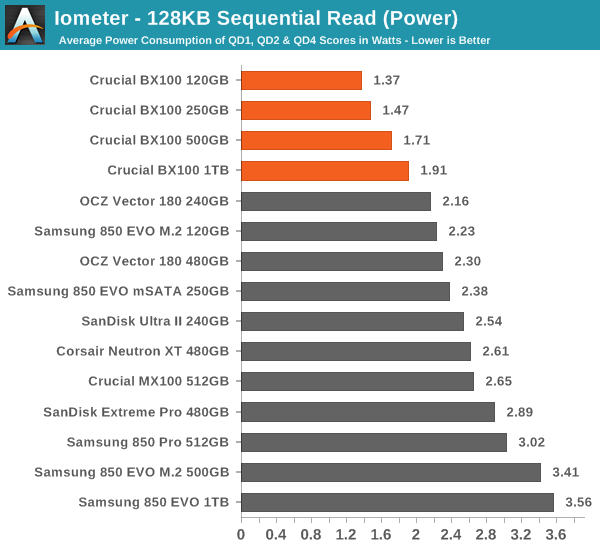
But power consumption presents large differences, which are in favor of the BX100.
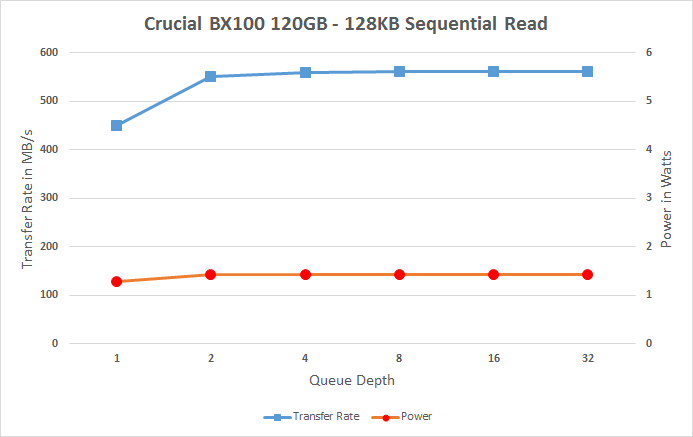 |
|||||||||
Sequential Write Performance
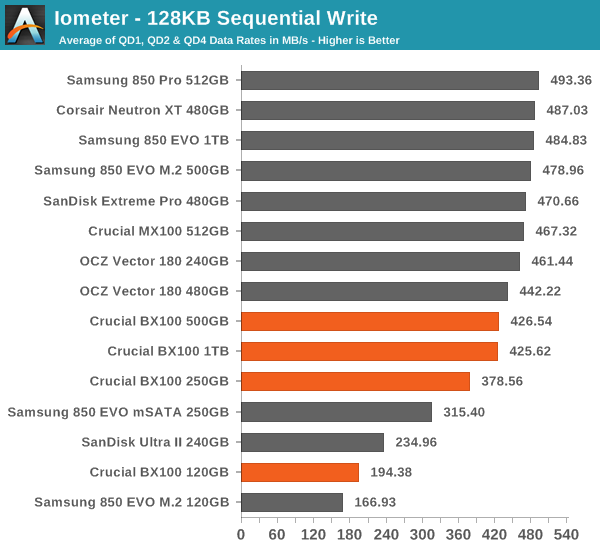
Compared with other value drives, namely 850 EVO and Ultra II, the BX100 performs relatively well, although the SM2246EN seems to hit its maximum speed faster than the others as the performance doesn't scale much with 500GB and higher.
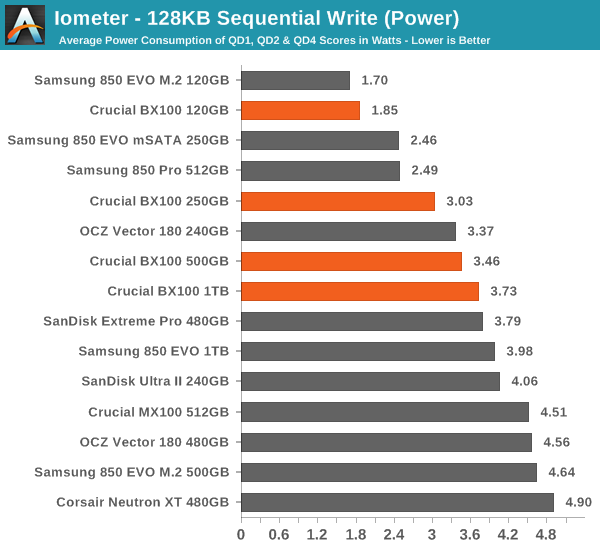
Power efficiency is still very good, though.
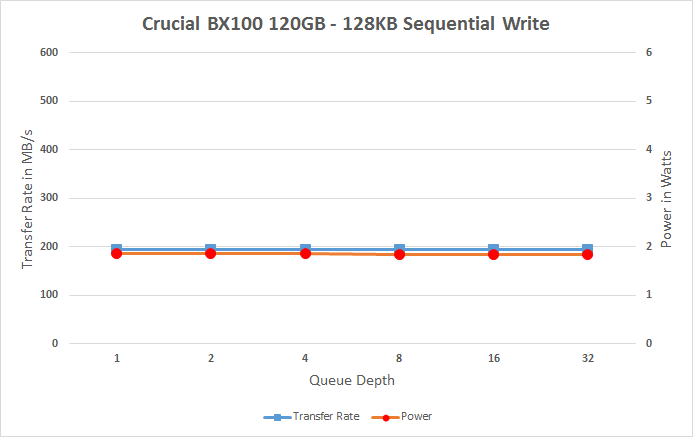 |
|||||||||
Looking at the scaling shows why the BX100 can't match the others as it maxes out at 450MB/s (which is also the rated sequential write speed).
Mixed Random Read/Write Performance
For full details of how we conduct our Iometer tests, please refer to this article.
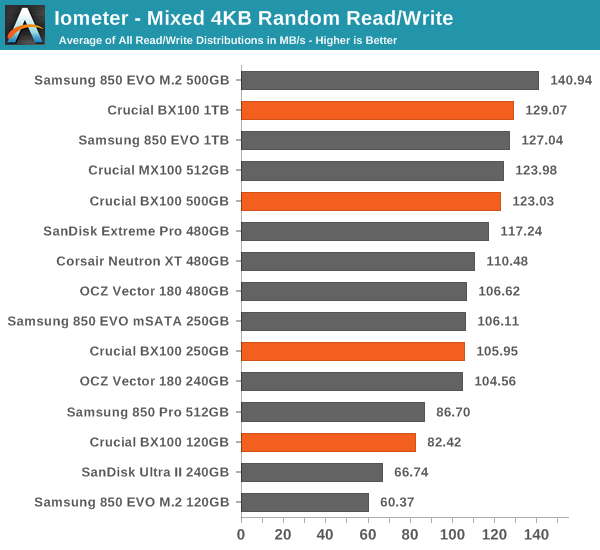
The BX100 and SM2246EN appears to do very well under mixed random workloads as it's nearlty the fastest drive we have tested, while still providing high power efficiency.
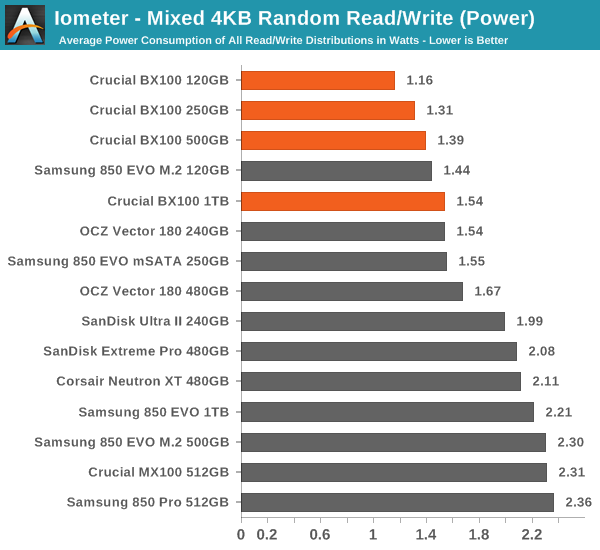
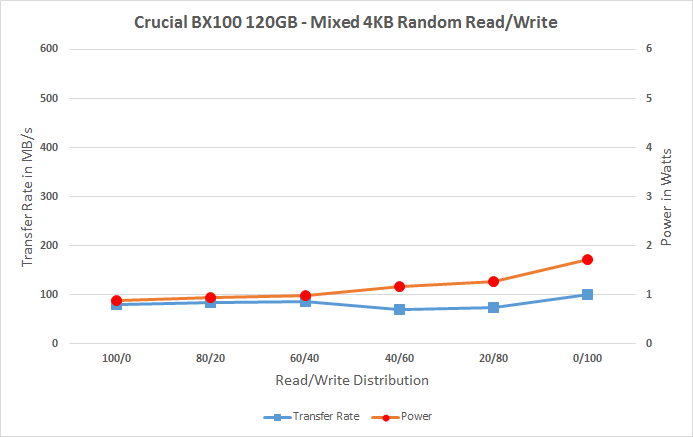 |
|||||||||
The reason lies in high, consistent performance as the BX100 performs about the same at all read/write distributions excluding the higher capacity models that scale lightly as the portion of writes is increased.
Mixed Sequential Read/Write Performance
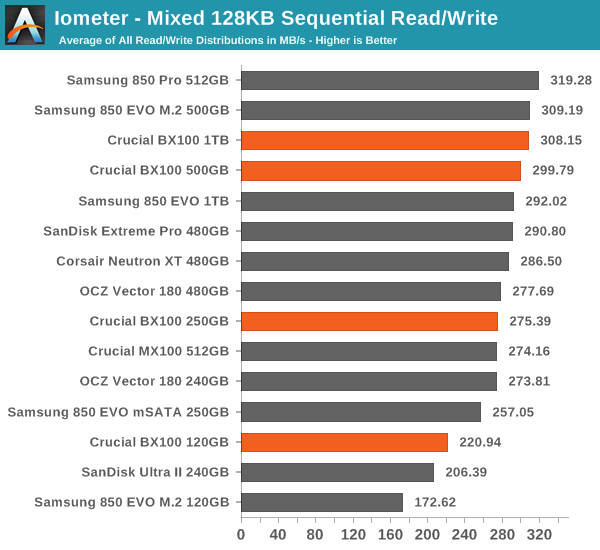
Mixed sequential performance is similarly good and there isn't even a big drop in performance at the smaller capacities. As we've already seen, power efficiency is very high too.
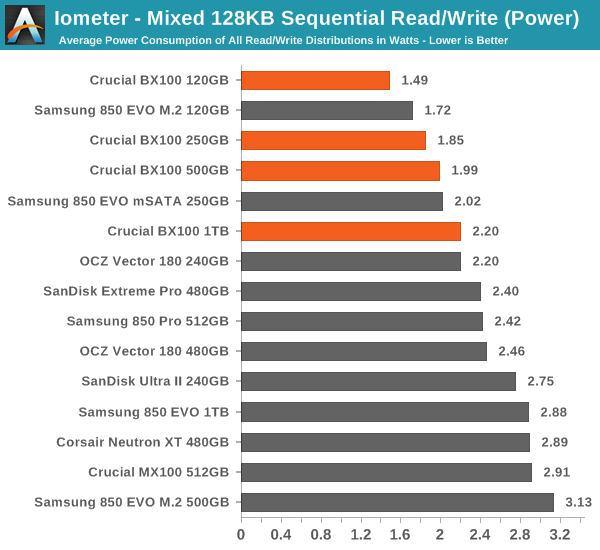
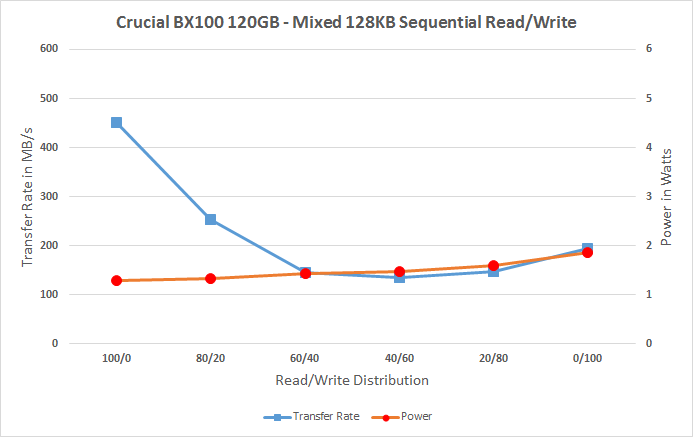 |
|||||||||
The BX100 does have a similar bathtub curve as others, but the good news is that the performance doesn't drop too much with mixed workload and the performance at 80/20 and 20/80 distributions is high.
ATTO - Transfer Size vs Performance
ATTO is a handy tool for quickly measuring performance across various transfer sizes and it's also freeware that can easily be run by the end-user.
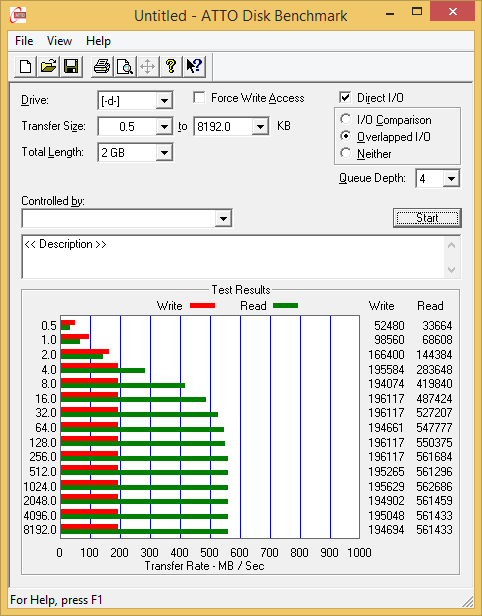 |
|||||||||
AS-SSD Incompressible Sequential Performance
Similar to ATTO, AS-SSD is freeware as well and uses incompressible data for all of its transfers, making it a valuable tool when testing drives with built-in compression engines (e.g. SandForce).
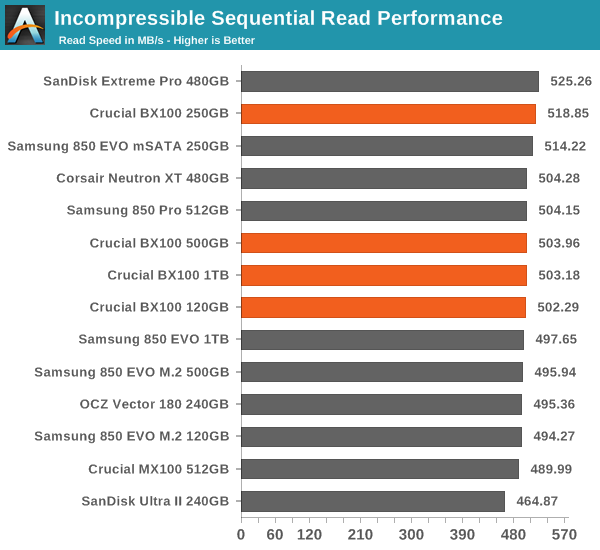
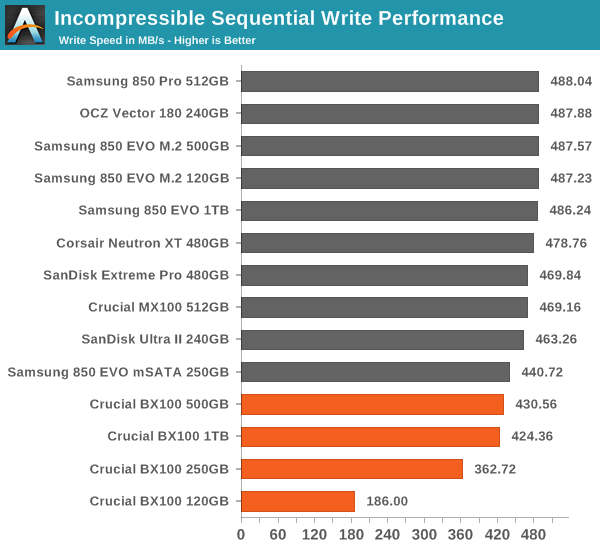
Idle Power Consumption
Since we truncate idle times to 25µs in our Storage Bench traces, they don't give a fully accurate picture of real world power consumption as idle power consumption is not taken properly into account. Hence I'm still reporting idle power consumption as a separate benchmark because it's one of the most critical metrics when it comes evaluating an SSD for mobile use.
Unfortunately I still don't have a way to test DevSleep power consumption due to lack of platform support, but my testbed supports HIPM+DIPM power commands (also referred to as Slumber power), so the results give a rather accurate picture of real-world idle power consumption.
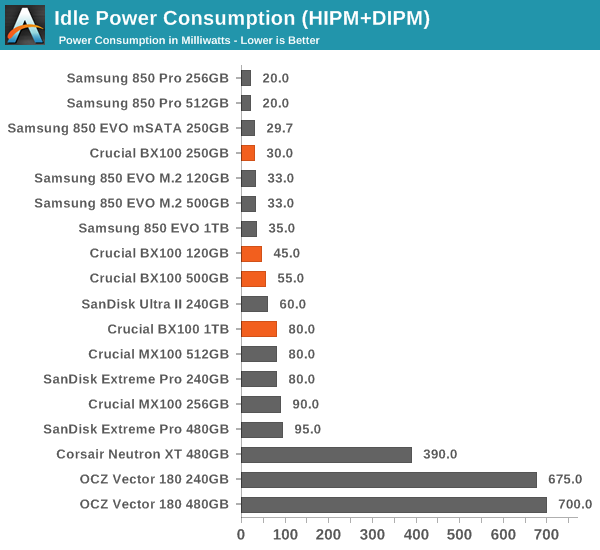
We've already seen that the BX100 is super efficient under load and what makes the news even better is that it also has excellent power consumption in idle/slumber mode. The BX100 seems to be an ideal fit for a laptop with its efficient power characteristics.
TRIM Validation
The move from Windows 7 to 8.1 introduced some problems with the methodology we have previously used to test TRIM functionality, so I had to come up with a new way to test. I tested a couple of different methods, but ultimately I decided to go with the easiest one that can actually be used by anyone. The software is simply called trimcheck and it was made by a developer that goes by the name CyberShadow in GitHub.
Trimcheck tests TRIM by creating a small, unique file and then deleting it. Next the program will check whether the data is still accessible by reading the raw LBA locations. If the data that is returned by the drive is all zeros, it has received the TRIM command and TRIM is functional.
And TRIM works.
Final Words
The MX100 was a revolutionary product in many ways. It was the first drive to move to sub-19nm NAND, which brought cost savings along with it. The combination of price and performance made the MX100 arguably one of the most cost efficient drives on the market. The BX100 is more of an evolutionary step from the MX100 as it uses the same 16nm MLC as its foundation, but the switch from a Marvell to a Silicon Motion controller has allowed Crucial to cut the costs by another few percent, while still retaining high performance in typical client workloads.
Talking about performance, the BX100 is a great all-around performer. It performs well regardless of the workload and despite not being designed for IO intensive workloads such as The Destroyer benchmark, the higher capacities (500GB & 1TB) manage to be very close to the higher-end drives. It actually begs a question of whether it's worth it to pay the premium for a high-end drive because in reality you will only be gaining about 10-15% higher performance, whereas the cost premium is much more than that. For professionals who truly need the best IO performance, the premium can be worth it (although you should really be looking at PCIe SSDs already), but for enthusiasts it's safe to say that the BX100 delivers far more bang for the buck than a high-end SSD does (unless you're looking for a 256GB drive or smaller).
Furthermore, the BX100 is extremely power efficient and without a doubt the best drive in terms of power consumption that we have tested. For desktop users that isn't a big deal (unless you pay very close attention to your power bill), but for laptop users I would argue that power consumption is just as important as performance is (if not even more important) because increased battery life is something concrete and easily noticeable.
My only criticism is the fact that Crucial decided not to include TCG Opal and eDrive encryption in the BX100. Like I mentioned on the first page, I understand that the reason behind the move is to differentiate the BX100 and MX200, but it's still a feature that we got accustomed to in Crucial SSDs. I can't say this is a major issue because hardware encryption in the client space is still in its infancy and the software support is poor, but nevertheless it's a feature that I would have liked to see included.
| Amazon Price Comparison (4/10/2015) | ||||
| 120/128GB | 240/250/256GB | 480/500/512GB | 960GB/1TB | |
| Crucial BX100 | $68 | $99 | $185 | $375 |
| Crucial MX200 | - | $110 | $200 | $430 |
| OCZ ARC 100 | $60 | $105 | $170 | - |
| Crucial MX100 | $72 | $110 | $210 | - |
| Intel SSD 530 | $89 | $133 | $245 | - |
| Mushkin Reactor | - | - | - | $371 |
| Samsung SSD 850 EVO | $65 | $107 | $190 | $380 |
| Samsung SSD 850 Pro | $100 | $155 | $290 | $500 |
| SanDisk Ultra II | $70 | $95 | $180 | $360 |
| SanDisk Extreme Pro | - | $146 | $285 | $475 |
| Transcend SSD370 | $58 | $99 | $176 | $360 |
Given that the MX100 was already driving prices down, it comes as no surprise that the BX100 is very competitive in price. The Ultra II and SSD370 are slightly cheaper, but neither of them can provide the same combination of performance and power efficiency as the BX100 does. On that basis I would pick the BX100 over the two since the price delta is rather insignificant anyway (and obviously, pricing fluctuates on a daily and retailer basis). The 850 EVO is also very close in price and offers a little higher performance, but it can't challenge the BX100 in power efficiency, so for mobile users my recommendation would be the BX100, whereas the 850 EVO does offer marginally better value for desktop users.
In a nutshell, I have nothing but positive things to say about the BX100 for its price point, especially when it comes to the higher capacities. The performance is good for all workloads, the power efficiency is top of the class and most importantly, the overall value you get is simply outstanding. If you are on the market for an SSD right now, especially for laptop, I would highly recommend the BX100 even if your workload happens to be heavier than average.

